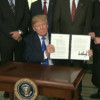The White House says the U.S. trade deficit with China is too high…but it may it be a lot lower than it seems.
The U.S. imported 463 billion dollars in goods from China in 2016 and exported 116 billion.
Let’s do the math. Subtract imports from exports and we get a U.S. deficit of 347 billion.
President Trump says based on this calculation, China is beating the U.S. in trade. The question is by how much? Well…not by as much as this first set of figures suggests.
When you factor in a second set…the deficit is lower. In 2016, the U.S. ran a surplus of $37.3 billion with China in services.
The U.S. Congress says that was the largest surplus the U.S. ran with any of its trading partners.
And when we take a closer look at China-U.S. in goods, the deficit is lower still.
Not all imports from China are actually “Chinese.” A big chunk of them – are so-called “intermediate goods.”
That are parts made in other countries—assembled in China and then shipped back for sale.
According to Oxford University, when we subtract the value of non-Chinese intermediate goods, it cuts the size of the U.S. trade deficit with China by half. That brings the China trade deficit closer to the one the U.S. ran with the European Union.
If the value of these imported components is subtracted from China’s exports, the US trade deficit with China is reduced by half…about the same as the U.S. trade deficit with the European Union.
So, let’s consider the iPhone.
The U.S. magazine, Forbes, says to produce the 2009 version, Chinese factories used 11 dollars’ worth of parts imported from U.S. companies.
And 172 dollars’ worth of components from other countries. But when they are shipped back to the U.S., the Phone sold roughly $600. And what did Chinese companies earn out of all this? Around $6.50. Just over 1 percent of the retail price. Apple, and other American companies, received 70 percent of the retail value.
However, U.S. official trade data shows nearly the full value of an iPhone belonging to China. THAT…apparently inflated the size of the U.S. deficit.
Global supply chains make U.S. trade figures misleading. They show where products are imported from, but don’t show everyone who benefits from the trade.
And here’s one more myth to bust—that trade with China is a job killer.
However, 88 percent of American job losses were due to automation, according to Ball State University Center for Business and Economic Research.
U.S. research shows automation has been wiping out U.S. jobs.
And trade has been creating them!
Fro 2010 to 2015, U.S. imports from China up 32 percent, and U.S. manufacturing jobs up 7 percent.
In fact, between 2010 and 2015, U.S. imports from China went up…and so did the number of U.S. manufacturing jobs!
Finally, here’s another factor skewing the trade figures. China wants to buy more high-tech goods from the U.S., but the U.S. bans their sale out of “national security concerns.” By some estimates…if the U.S. lowered barriers for high-tech exports to China to the same level as France, it could cut the deficit to China by as much as 34 percent.
So, from China’s perspective, any reasonable negotiation on cutting the deficit may have to start…with how to calculate it.
 CGTN America
CGTN America

